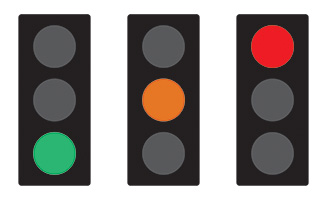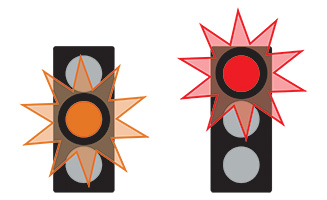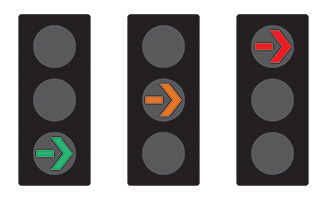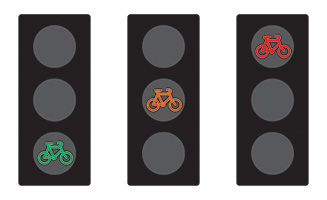The signs, road markings, traffic lights and give way rules at intersections with traffic lights generally work the same for everyone on the road.
This page describes:
Traffic lights
Arrow traffic lights and turning lanes
Bus-priority traffic lights
Bike-specific traffic lights
At intersections with traffic lights, the traffic lights control the give way rules. You must stay in your lane until you have passed the intersection.

Traffic signals
A red signal means you must stop
A yellow signal means the lights will soon turn red. You must stop, unless you are so close to the intersection that you can't stop.
A green signal means you can go if it's safe.
There are a few bike-specific signs, markings and traffic lights that help you use intersections.
With standard traffic lights, you still need to give way in some situations.

Flashing traffic signals
If you see red flashing lights, you must stop before the limit line marked on the road, and stay stopped until they stop flashing. You may see red flashing lights near places such as railway crossings, fire stations and ambulance stations.
A flashing yellow signal, or no signal at all, means the traffic lights are not working. You
must follow the give way rules like you would for uncontrolled intersections.
When arrows are displayed on traffic lights, they apply to vehicles turning in the direction the arrow is pointing. They are generally used together with dedicated turning lanes.
If no arrow is displayed, follow the rules for the standard traffic lights that apply to the lane you are riding in and the direction you want to go.
The full range of traffic light and arrow combinations are described in the give way rules section of the online Road Code.
Official Road Code give way rules

Arrow traffic signals
A red arrow means you must stop if you are travelling in the direction the arrow is pointing.
A yellow arrow means you must stop if you are travelling in the direction the arrow is pointing, unless you are so close to the intersection that you can’t stop.
A green arrow means you can go if you are travelling in the direction the arrow is pointing.

Bus-priority light
Some intersections have specific lanes and traffic lights for buses. If you’re waiting in a bus lane with bus-priority traffic lights, go when the white ‘B’ light shows. This light gives a head start to you and any buses in the lane.
Some intersections have specific traffic lights just for people riding bikes. For example, the lights might allow riders to start before other traffic, or they might control riders on cycle paths or shared paths. Bike-specific traffic lights are marked with a bike symbol.
If no bike symbol is displayed, follow the rules for the standard traffic lights that apply to the lane you are riding in and the direction you want to go.

Cycle traffic lights
A red bike symbol means you must stop.
A yellow bike symbol means you must stop, unless you are so close to the intersection that you can’t.
A green bike symbol means you can go if it’s safe.
Many bike-specific traffic lights only have red and green lights.